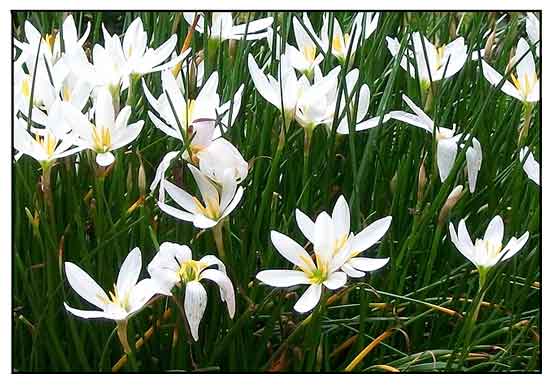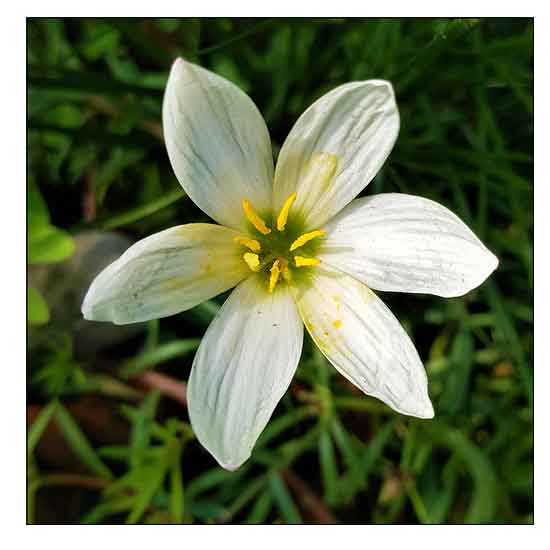 Gen info Gen info
- Zephyranthes candida was first described by John Lindley in 1823 as Amaryllis candida, and was transferred to the current genus in 1826 by William Herbert. (2)
- Etymology: The genus name Zephyranthes derives from Greek word zephyros meaning "the west wind" (Zephyrus is the name of the Greek god of the west wind" and anthos meaning "flower: The specific epithet candida means "pure white or shining".
Botany
Bulbs ovoid, ca. 2.5 cm in diam., neck 2.5--5 cm. Leaves bright green, terete-linear, 20--30 cm × 2--4 mm, fleshy. Involucres red-brown. Flowers solitary, terminal; pedicel ca. 1 cm. Perianth white, often tinged with rose abaxially; lobes ± free, 3--5 × ca. 1 cm, usually with tiny scales near throat, apex obtuse to shortly acute. Stamens ca. 1/2 as long as perianth. Style slender; stigma 3-notched. Capsule subglobose, ca. 1.2 cm in diam. (Flora of China)
Distribution
- Introduced.
-
Cultivated; not naturalized.
- Native to Argentina, Brazil, Paraguay, Uruguay.
- Widely cultivated as an ornamental; naturalized in many places.
Constituents
- Study of whole plants of Zephyranthes candida isolated seven new alkaloids, N-methylhaemanthidine chloride (1), N-methyl-5,6-dihydroplicane (5),  O-methylnerinine (6), N-ethoxycarbonylethylcrinasiadine (7), N-ethoxycarbonylpropylcrinasiadine (8), N-phenethylcrinasiadine (9) and N-isopentylcrinasiadine (10), together with eight known alkaloids, haemanthamin (2), 3-epimacronine (3), (+)-tazettine (4), O-methylnerinine (6), N-ethoxycarbonylethylcrinasiadine (7), N-ethoxycarbonylpropylcrinasiadine (8), N-phenethylcrinasiadine (9) and N-isopentylcrinasiadine (10), together with eight known alkaloids, haemanthamin (2), 3-epimacronine (3), (+)-tazettine (4),
N-methylcrinasiadine (11), trisphaeridine (12), 5,6-dihydrobicolorine (13), lycorine (14), and nigragillin (15). (see study below) (4)
- Study of whole plant isolated eight compounds, namely: (2S)-3',7-dihydroxy-4'-methoxyflavan (1), beta-sitosterol (2), stigmasta-5,22-dien-3beta-ol (3), stigmasterol (4), beta-daucosterin (5), Butylisobutyl phthalat (6), Heptacosane (7) and Ambrettolide (8).
(5)
- Methanol leaf extract yielded flavonoids, glycosides, and alkaloids. (see study below) (9)
- Study of bulbs isolated and identified six compounds:
trisphaeridine (1), p-hydroxybenzaldehyde (2), sucrose (3), (-)-amarbellisine (4), lycorine (5), (+)-haemanthamine (6). (10)
- Study of flowers for volatile oils yielded 54 compounds corresponding to 70.7% of total composition. Major volatile components were esters (24.7%), alcohols (22.3%), and terpenes (5.3%), including five monoterpenes (1.7%), and nine sesquiterpenes (3.6%)
. Major constituents of essential oil of fresh flowers were fatty acids (22.05%), terpenes (13.53%), alkanes (13.19%), and aldehydes (6.93%). (11)
Properties
- Studies have suggested anticancer, anti-inflammatory, antidiabetic, antioxidant, antitumor, anti-acetylcholinesterase, antineoplastic, antibacterial properties.
Parts used
Leaves, flowers.
Uses
Folkloric
- No reported folkloric medicinal use in the Philippines.
-
In South Africa and tribes of Andhra Pradesh in India, decoction of leaves used as remedy for diabetes mellitus.
-
In China, used for infantile convulsions, tetanus, and epilepsy.
- In Indian System of Traditional Medicine, used for treatment of diabetes.
Studies
• Cytotoxic Alkaloids / Anticancer / Whole Plants: Study of whole plants of Zephyranthes candida isolated seven new alkaloids, N-methylhaemanthidine chloride (1), N-methyl-5,6-dihydroplicane (5), O-methylnerinine (6), N-ethoxycarbonylethylcrinasiadine (7), N-ethoxycarbonylpropylcrinasiadine (8), N-phenethylcrinasiadine (9) and N-isopentylcrinasiadine (10), together with eight known alkaloids. Compounds 1-15 were evaluated for in vitro cytotoxicity against five human cancer cell lines and Beas-2B (non-cancerous) human bronchial epithelial cell line. Compounds 1, 2, 9, and 14 exhibited cytotoxicity with IC50s ranging from 0.81 to 13 µM with selectivity indices as high as 10. (see constituents above) (4)
• Silver Nanoparticles / Flowers: Study reports on the simple, cost-effective, reproducible, green synthesis of silver nanoparticles using Zephyranthes candida flower extract. The AgNPs showed potent antidiabetic, antioxidant, anti-inflammatory and anticancer activities. (6)
• Zephycandidine A /Antitumor / Anti-Acetylcholinesterase: Study isolated Zephycandidine A (ZA), the first naturally occurring imidazo[1,2-f]phenanthridine alkaloid, from Z. candida. The compound exhibited significant cytotoxicity against five cancer cell lines with IC50s ranging from 1.98 to 7.03 µM with selectivity indices as high as 10 when compared to normal Beas-2B cell. Zephycandidine A also induces apoptosis in leukemia cells by activation of caspase-3, upregulation of Bax, downregulation of Bcl-2 and degradation of PARP expression. The compound also showed acetylcholinesterase (AChE) inhibitory activity. (7)
• Poliovirus-Inhibiting Constituents: A previous study of Z. candida suggest it to have antiviral properties, which led to an anti-poliovirus assay-guided isolated of compounds from a crude methanol extract of the plant. Three compounds were isolated from the chloroform fractions, namely: licorine (1), trisphaeridine (2), and 7-hydroxy-3',4'-methylenedioxyflavan (3). of the three anti-polioviral components, lycorine was the most active, with IC 50 of 0.058 µg/mL, followed by trisphaeridine with IC50 0.1427 µg/mL, and compound 3 with IC50 of 0.2384 µg/mL. The compounds showed moderate toxicity with good SI, with potential as template for a new antiviral agent. (8)
• Antidiabetic / Leaves: Study evaluated the anti-diabetic activity of methanolic leaf extract of ZC (MLZ) and fractions in healthy and STZ-induced diabetic rats. The MLZ at doses of 100, 200, and 400 mg/kg) showed significant reduction in blood glucose levels comparable to antidiabetic drug, glipizide. Total cholesterol, triglycerides, and LDL were also significantly reduced. All three fractions also reduced blood glucose after single administration (p<0.01). The MLZ showed presence of flavonoids, glycosides, and alkaloids. (9)
• Antineoplastic / Cytostatic / Trans-Dihydronarciclasine: Study of Z. candida isolated a cytostatic constituent. Separation of a n-BuPH extract directed by results of bioassay employing P-388 lymphocytic leukemia led to trans-dihydronarciclasine as the principal cytostatic agent with ED50 3.2x10-3 µg/ml. (12)
• Antibacterial / Leaves: Study evaluated the antibacterial activity of methanolic extract of Z. candida leaves against B. subtilis, K. pneumonia, E. coli, P. aeruginosa, S. aureus and E. aerogenes by Agar well diffusion method. Inhibition zones were 0, 3, 8.5, 6, 8, and 7 mm, respectively. (13)
Availability
Wild-crafted.
Seeds, plants in the cybermarket. |

![]()





